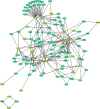Riboflavin deficiency induces a significant change in proteomic profiles in HepG2 cells
- PMID: 28367977
- PMCID: PMC5377456
- DOI: 10.1038/srep45861
Riboflavin deficiency induces a significant change in proteomic profiles in HepG2 cells
Abstract
Riboflavin deficiency is widespread in many regions over the world, especially in underdeveloped countries. In this study, we investigated the effects of riboflavin deficiency on protein expression profiles in HepG2 cells in order to provide molecular information for the abnormalities induced by riboflavin deficiency. HepG2 cells were cultured in media containing different concentrations of riboflavin. Changes of cell viability and apoptosis were assessed. A comparative proteomic analysis was performed using a label-free shotgun method with LC-MS/MS to investigate the global changes of proteomic profiles in response to riboflavin deficiency. Immunoblotting test was used to validate the results of proteomic approach. The cell viability and apoptosis tests showed that riboflavin was vital in maintaining the cytoactivity of HepG2 cells. The label-free proteomic analysis revealed that a total of 37 proteins showing differential expression (±2 fold, p < 0.05) were identified after riboflavin deficiency. Bioinformatics analysis indicated that the riboflavin deficiency caused an up-regulation of Parkinson's disease pathway, steroid catabolism, endoplasmic reticulum stress and apoptotic process, while the fatty acid metabolism, tricarboxylic citrate cycle, oxidative phosphorylation and iron metabolism were down-regulated. These findings provide a molecular basis for the elucidation of the effects caused by riboflavin deficiency.
Conflict of interest statement
The authors declare no competing financial interests.
Figures





Similar articles
-
Riboflavin (Vitamin B2) Deficiency Induces Apoptosis Mediated by Endoplasmic Reticulum Stress and the CHOP Pathway in HepG2 Cells.Nutrients. 2022 Aug 16;14(16):3356. doi: 10.3390/nu14163356. Nutrients. 2022. PMID: 36014863 Free PMC article.
-
Riboflavin deficiency causes protein and DNA damage in HepG2 cells, triggering arrest in G1 phase of the cell cycle.J Nutr Biochem. 2006 Apr;17(4):250-6. doi: 10.1016/j.jnutbio.2005.05.004. Epub 2005 Jun 13. J Nutr Biochem. 2006. PMID: 16109485 Free PMC article.
-
Riboflavin deficiency impairs oxidative folding and secretion of apolipoprotein B-100 in HepG2 cells, triggering stress response systems.J Nutr. 2005 May;135(5):978-82. doi: 10.1093/jn/135.5.978. J Nutr. 2005. PMID: 15867268 Free PMC article.
-
Update on clinical aspects and treatment of selected vitamin-responsive disorders II (riboflavin and CoQ 10).J Inherit Metab Dis. 2012 Jul;35(4):679-87. doi: 10.1007/s10545-011-9434-1. Epub 2012 Jan 10. J Inherit Metab Dis. 2012. PMID: 22231380 Review.
-
Clinical presentation and outcome of riboflavin transporter deficiency: mini review after five years of experience.J Inherit Metab Dis. 2016 Jul;39(4):559-64. doi: 10.1007/s10545-016-9924-2. Epub 2016 Mar 14. J Inherit Metab Dis. 2016. PMID: 26973221 Free PMC article. Review.
Cited by
-
From Metabolism to Vitality: Uncovering Riboflavin's Importance in Poultry Nutrition.Animals (Basel). 2023 Nov 17;13(22):3554. doi: 10.3390/ani13223554. Animals (Basel). 2023. PMID: 38003171 Free PMC article. Review.
-
Flavins Act as a Critical Liaison Between Metabolic Homeostasis and Oxidative Stress in the Retina.Front Cell Dev Biol. 2020 Aug 27;8:861. doi: 10.3389/fcell.2020.00861. eCollection 2020. Front Cell Dev Biol. 2020. PMID: 32984341 Free PMC article. Review.
-
Maternal diet deficient in riboflavin induces embryonic death associated with alterations in the hepatic proteome of duck embryos.Nutr Metab (Lond). 2019 Mar 14;16:19. doi: 10.1186/s12986-019-0345-8. eCollection 2019. Nutr Metab (Lond). 2019. PMID: 30918526 Free PMC article.
-
Riboflavin Stabilizes Abasic, Oxidized G-Quadruplex Structures.Biochemistry. 2022 Feb 15;61(4):265-275. doi: 10.1021/acs.biochem.1c00598. Epub 2022 Feb 1. Biochemistry. 2022. PMID: 35104101 Free PMC article.
-
Vitamin combination promotes ex vivo expansion of NK-92 cells by reprogramming glucose metabolism.Bioresour Bioprocess. 2022 Aug 26;9(1):87. doi: 10.1186/s40643-022-00578-4. Bioresour Bioprocess. 2022. PMID: 38647839 Free PMC article.
References
-
- Hoey. L., McNulty H. & Strain J. J. Studies of biomarker responses to intervention with riboflavin: a systematic review. Am J Clin Nutr 89, 1960–1980 (2009). - PubMed
-
- McNulty H. et al.. Riboflavin lowers homocysteine in individuals homozygous for the MTHFR 677C → T polymorphism. Circulation 13, 74–80 (2006). - PubMed
-
- Powers H. J. et al.. Correcting a marginal riboflavin deficiency improves hematologic status in young women in the United Kingdom (RIBOFEM). Am J Clin Nutr 93, 1274–1284 (2011). - PubMed
Publication types
MeSH terms
Substances
LinkOut - more resources
Full Text Sources
Other Literature Sources
Medical

